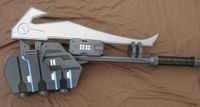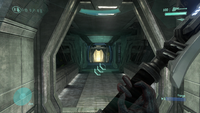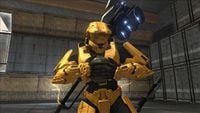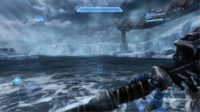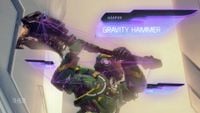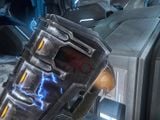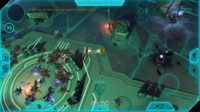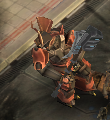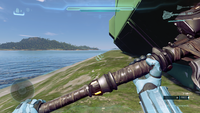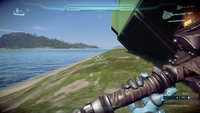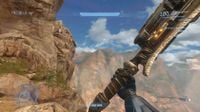Gravity hammer
From Halopedia, the Halo wiki
- "One hit from that hammer and you ended up a puddle of bones and blood."
- — Private Aaron Landvik[1]
The Type-2 Energy Weapon/Hammer (T2 EW/H), more commonly known as the gravity hammer, is a powerful, close-quarters, two-handed melee weapon used by the Jiralhanae.[2][3]
Overview
Background
The gravity hammers evolved from traditional war hammers wielded by Jiralhanae war chieftains,[4] which were a major focus of the Jiralhanae's barbaric culture, as it serves as the ultimate symbol of clan leadership in addition to being a powerful weapon. The ceremonial hammer of a pack or a clan is only passed to another Jiralhanae if he can best his chieftain in ceremonial combat; the mantle of leadership passes along with the weapon.[3] The wielder of the weapon was expected to treat their gravity hammer with great care.[5]
When the Jiralhanae were incorporated into the Covenant, advanced Covenant technologies were adapted by the Jiralhanae and applied to their war hammers. After Tartarus' rise to power, many war hammers of chieftains were commissioned into the contemporary gravity hammer, with components of the ancestral hammers incorporated when possible.[4]
Design
Though gravity hammers used by Jiralhanae serving in the Covenant military tend to follow a standard design, not all are functionally or aesthetically identical; gravity hammers are often tailored to suit the desires of specific clans, families, or packs.[3] The first gravity hammer and the template for the standardized weapons of this type was the Fist of Rukt, an ancestral war hammer of Maccabeus' clan which was upgraded with Covenant gravity technology after Tartarus was appointed the Chieftain of the Jiralhanae in the Covenant.[6]
Though individual gravity hammers are crafted differently, the design of the standard Type-2 EW/H is rather simple, being composed of a long haft and a heavy head with a tungsten-alloy blade on the reverse end. Within the head is a short-range shock-field-generating gravity drive[7] that uses gravity impellers[8] that are often re-purposed from other technology[9] to emit a kinetic pulse around 4.5 meters outward; this device was added to the weapon shortly after the Jiralhanae's incorporation into the Covenant in 2492.[2][3] This device can displace gravity in targeted locations and manipulate localized energy fields,[7] though the Jiralhanae's brutal nature means that they often prefer to use the weapon in melee combat.[3] This allows the ability to pull a target towards that wielded or push it away as well as even create a vortex which pulls things in and then detonates the vortex to push things out.[10][11][12][13] The exact mechanism by which it functions is currently under investigation by the UNSC.[2]
Variants
Corpsemaker
Made of the finest materials its creator could coerce or steal from raider lairs on Warial and Teash. Improved Gravity Hammer with faster swing time and additional energy capacity.[14]
Grinder
The sound of overloading shields, cracking bones, and shattering armor is music to Jiralhanae ears. Improved Gravity Hammer with uncalibrated impellors that generate an unstable gravimetric vortex at the point of impact.[14]
Tartarus' Gavel
During his ascent to power within the Covenant, Tartarus used his relationship with the Prophets to reward loyal lieutenants with advanced weaponry secretly forged within the Sacred Promissory; one such hammer was the Tartarus' Gavel.[15] Mythic Gravity Hammer that unleashes a linear series of kinetic explosions with each swing. Equipping Tartarus' Gavel also boosts movement speed, shield strength, and jump height.
Gameplay
Advantages
The gravity hammer is a very powerful weapon, useful in close quarters combat. With a bit of skill, they can even be effectively used against vehicles, usually offering an instant kill. The hammer has a splash damage effect, and a well-placed hit could kill multiple foes in one swing. In some aspects, it is more powerful than the energy sword - a kill against a Covenant enemy or an opponent in multiplayer uses 10% of the energy sword's battery, whereas the gravity hammer only uses 8.33%. When timed perfectly, the gravity hammer can even be used to deflect certain objects, such as rockets and even grenades. In campaign or firefight, 5% of the hammer's battery is used per swing.
Disadvantages
- The gravity hammer is huge and visible, so when wielding it as a primary or secondary weapon, you risk making yourself a prime target for snipers.
- If you swing the hammer too slowly or out of range, it will push your opponent back, making it harder for you to finish him off and easier for him to counter your attack.
- The glowing blue vents at the top of the weapon are still visible when a player has active camouflage.
- The large area of effect of the weapon means that using it in tight quarters with friendly players is highly inadvisable.
- An enemy wielding a shotgun can easily take down a player with the gravity hammer before he has time to swing.
- While the gravity hammer takes only 5% energy for a swing-- compared with the sword's 10% depletion, the sword only expends energy when it hits, the hammer wastes with every swing, regardless of if it hits or not.
- If the gravity hammer is being used as a player's secondary weapon, you cannot swing momentarily as it is wielded. The character must have rested his right hand on the handle before a swing can be attempted. This is similar to the energy sword having to ignite before a lunge is possible and might have been added due to balancing issues.
Halo Wars gameplay
In multiplayer and skirmish mode in Halo Wars, the Brute chieftain is armed with a gravity hammer. It features very powerful vortex ability that can rip objects apart and suck them in. When the vortex grabs units such as Marines, they will be battered by the shrapnel in the vortex and by their fellow squad members, in addition to being hurled violently. When the vortex leader power is put to a halt, either by the player's choosing or by enemy forces, an explosion will send everything in the vortex outward. Upgrades to the hammer include adding a stun, pulling enemies toward him, and increasing range and damage.
Gameplay changes
Changes from Halo 3 and Halo 3: ODST to Halo: Reach
- The lights on the head of the hammer are orange instead of blue.
- The head of the hammer is larger.
- The overall length of the hammer is somewhat shorter.
- The weapon now has a red decorative symbol on the head.
- The shaft's hand guard has been removed.
- The blast range isn't as wide. This is most noticeable in Grifball.
Changes from Halo: Reach to Halo 4
- Knock-back from the weapon is dramatically increased. A hit from this can send you flying, however, this can be used to the would-be victim's advantage to escape from the wielder.
- The sound of the hammer has changed.
- The blast radius has been increased.
Changes from Halo 4 to Halo 5: Guardians
- Like all other weapons in Halo 5: Guardians, the gravity hammer can now be smart-scoped. This increases lunge range noticeably.
- Base lunge range decreased slightly.
- Re-uses the reticle seen in Halo 3 and Halo Reach.
Trivia

|
See our gameplay information related to Gravity hammer on its gameplay page. |

|
Browse more images in this article's gallery page. |
Miscellaneous
- The gravity hammer is used in the popular playlist Grifball, in which the players have no shields and must somehow take their bomb and get it to the other team's base. The hammer is often used to create enough force to propel the bomb-carrying player over the heads of their opponents and into the goal.
- On the map Sandbox in Halo 3 as well as in all maps in Halo: Reach, there is a remodeled version of the gravity hammer called "7 wood". The 7 wood performs exactly the same gameplay wise, except it is modeled to look like a giant golf club and features a different reticule.
- The gravity hammer and Mauler are not in the Halo 3 instruction manual.
- Despite the lack of Brutes in the game, the gravity hammer appears in Halo 4, likely due to its unique gameplay niche, its fan-favoritism, and its important role in Grifball. It is consequently the only Brute weapon to appear in Halo 4. In the entirety of Halo 4's campaign, only one gravity hammer can be found, located in an armory during the last level.[16]
Glitches
- In Halo 3, the gravity hammer sometimes has no alternate third person animation for melee; in third-person, a player appears to swing the hammer with no explosive effect or splash effect. This only occurs with Spartan models. Sangheili models have the same animation they have if they melee someone with a flag. This has been fixed in Halo 3: ODST - the hammer now has a third person animation for melee.
- If the player pulls the right trigger while also pulling the left trigger, the shock wave will have no sound effect, the attack will be negated, and it will count as a normal melee attack. Pressing the right trigger and then immediately crouching produces the same effect.
- In the Halo 3 campaign, Sangheili, including the Arbiter, will not use gravity hammers if they are armed with them. They will simply run next to enemies and remain stationary.
Gallery
Close-up of the gravity hammer used in Halo: Landfall created by Weta Workshop.
First-person view of the gravity hammer in Halo 3.
- 1216073359 Chieftain.jpg
A chieftain wielding a gravity hammer.
- Brute Army Commander.jpg
A Jiralhanae Army Commander wielding his gravity hammer in Halo Wars.
- 96764571-Full.jpg
A War Chieftain wielding a gravity hammer in Halo 3: ODST.
The gravity hammer in Halo Reach.
Jiralhanae Captain wielding a gravity hammer.
The Gravity Hammer in Halo 4.
A Spartan-IV wielding the gravity hammer in Halo 4.
A Jiralhanae Chieftain swinging a gravity hammer at Spartan Davis in Halo: Spartan Assault.
A Jiralhanae Chieftain with a gravity hammer in Halo: Spartan Strike.
- H5G-GravityHammer.jpg
A gravity hammer in Halo 5: Guardians.
Smart scope with the gravity hammer in Halo 5: Guardians.
The gravity hammer in Halo Online.
Halo 5: Guardians REQ cards and variants
- H5G-GravityHammer.png
REQ card of the Gravity Hammer.
List of appearances
Sources
- ^ Halo: Spartan Assault, Pre-mission quotes
- ^ a b c Bungie.net: Halo: Reach Ordnance Page
- ^ a b c d e Halo Waypoint: Gravity Hammer (defunct, backup on Archive.org)
- ^ a b Cite error: Invalid
<ref>tag; no text was provided for refs nameduniverse - ^ Halo: Contact Harvest, page 258
- ^ Halo Waypoint: Fist of Rukt
- ^ a b Cite error: Invalid
<ref>tag; no text was provided for refs namedHalo 4 Guide - ^ Halo Waypoint: Canon Fodder - Storm Surge
- ^ Halo Waypoint: Hammer Storm: Gravity hammer
- ^ Halo Wars
- ^ Halo 2, campaign level The Oracle
- ^ Halo 2, campaign level Quarantine Zone
- ^ Halo 2, campaign level The Great Journey
- ^ a b Halo Waypoint - Canon Fodder: No Joke
- ^ Halo Waypoint: Canon Fodder - Close Quarters
- ^ Halo 4
|
| |||||||||||
